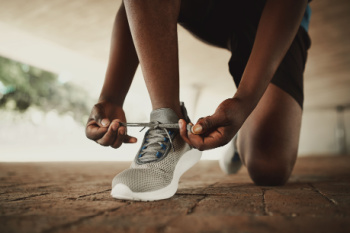
Running shoes and workout shoes are built to support the feet in different ways, based on how each activity affects movement and impact. Running shoes are designed to absorb repeated forward motion, with extra cushioning in the midsole to help reduce the pressure on the feet during long-distance runs. They often have a higher heel-to-toe drop to cushion the heel strike, which helps protect the arches and ankles from overuse injuries. In contrast, workout shoes are made for side-to-side movement, quick pivots, and a range of activities that demand better ankle support and foot stability. These shoes generally have flatter soles and flexible materials to allow natural foot motion during squats, jumps, or lateral drills. A podiatrist can help assess foot structure and advise on proper footwear to reduce injury risks and manage pain. If you are experiencing foot pain after working out or running, it is suggested that you schedule an appointment with a podiatrist for an exam, treatment options, and guidance in choosing the correct shoes for your desired activity.
It is important to find shoes that fit you properly in order to avoid a variety of different foot problems. For more information about treatment, contact Jack A. Sasiene, DPM from Texas. Our doctor will treat your foot and ankle needs.
Proper Shoe Fitting
Shoes have many different functions. They cushion our body weight, protect our feet, and allow us to safely play sports. You should always make sure that the shoes you wear fit you properly in order to avoid injuries and deformities such as: bunions, corns, calluses, hammertoes, plantar fasciitis, stress fractures, and more. It is important to note that although a certain pair of shoes might be a great fit for someone else, that doesn’t mean they will be a great fit for you. This is why you should always try on shoes before buying them to make sure they are worth the investment. Typically, shoes need to be replaced ever six months to one year of regular use.
Tips for Proper Shoe Fitting
- Select a shoe that is shaped like your foot
- Don’t buy shoes that fit too tight, expecting them to stretch to fit
- Make sure there is enough space (3/8” to ½”) for your longest toe at the end of each shoe when you are standing up
- Walk in the shoes to make sure they fit and feel right
- Don’t select shoes by the size marked inside the shoe, but by how the shoe fits your foot
The shoes you buy should always feel as good as they look. Shoes that fit properly will last longer, feel better, and improve your way of life each day.
If you have any questions please contact our offices located in Texas City and Lake Jackson, TX . We offer the newest diagnostic and treatment technologies for all your foot and ankle needs.
